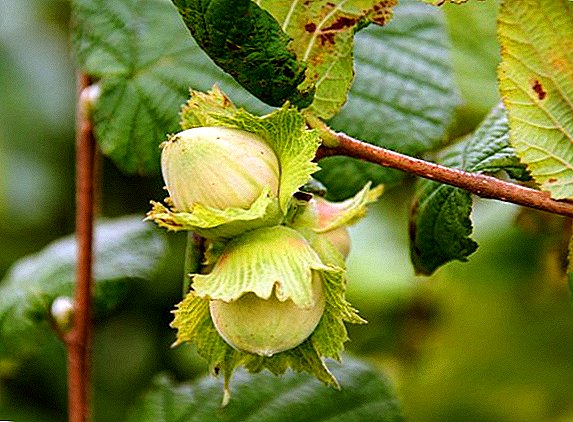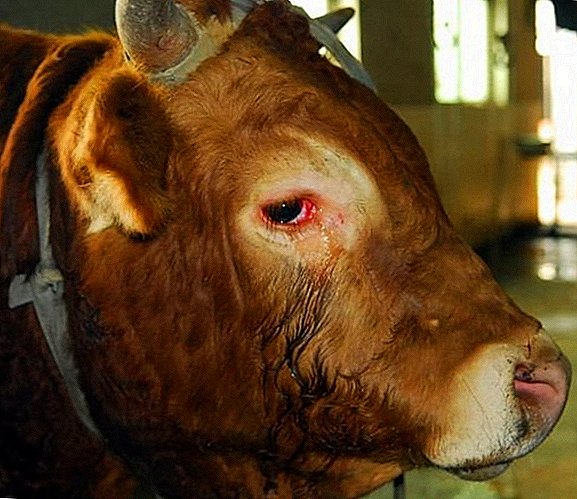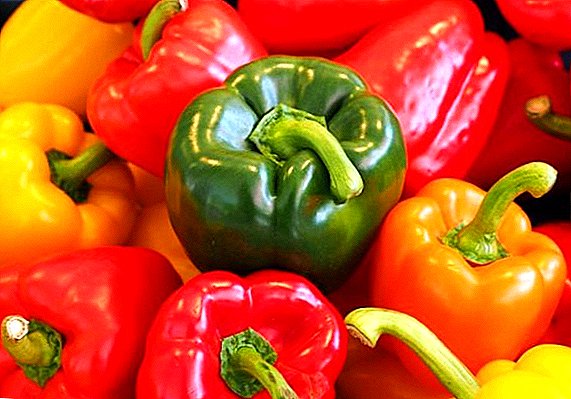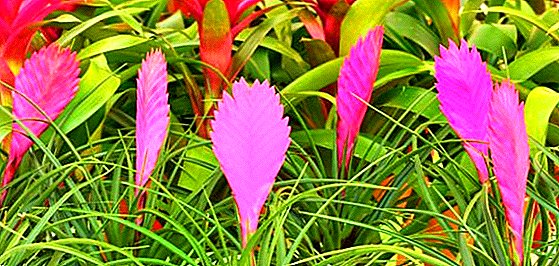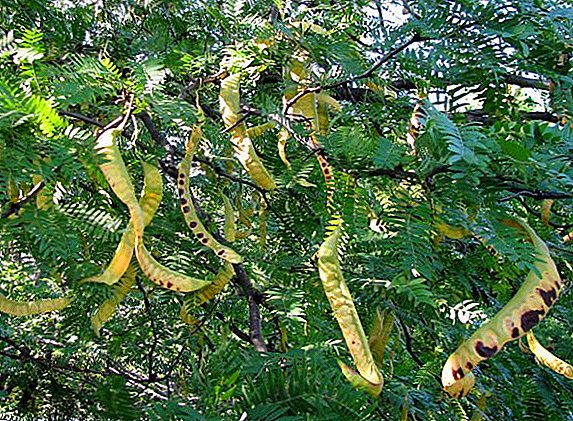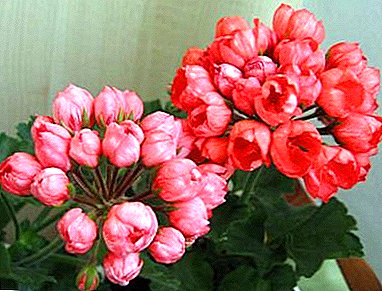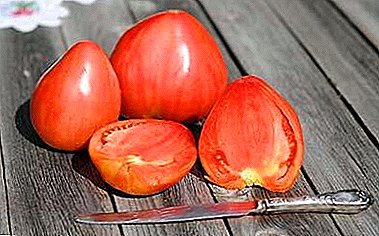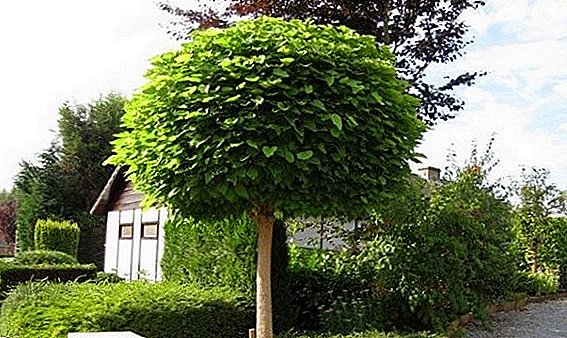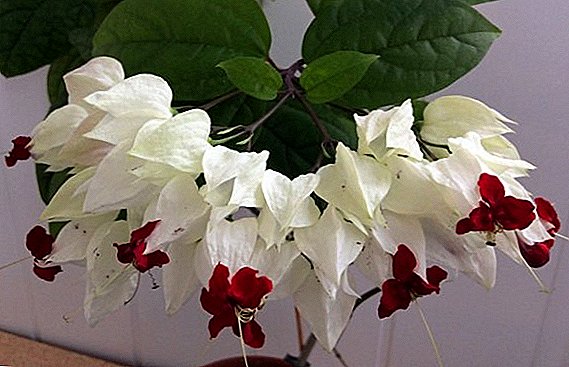 Mrs. Thompson's decorative liana's clerodendrum is valued among gardeners for its beautiful lush flowering and the possibility of growing both in the garden and at home in pots. How to grow a flower at home, read below.
Mrs. Thompson's decorative liana's clerodendrum is valued among gardeners for its beautiful lush flowering and the possibility of growing both in the garden and at home in pots. How to grow a flower at home, read below.
Botanical Description of Clerodendrum Thompson
The homeland of the plant is Africa and South America. Scottish discoverer J. Thompson brought flowers to Europe about 200 years ago. In honor of him, the plant got its name.
Did you know? The longest sushi plant is liana-like rattan. The length of its branches is 350 m.
The plant belongs to the Verbenov family. It is a climbing evergreen liana-like shrub. The length of the shoots can reach 4 m. The branches are flexible, durable. When grown in indoor conditions, the length of the shoots does not exceed 2 m.
Leaves petiolate type have an oval shape. Their length does not exceed 10 cm. They are densely arranged on the branches in an order. The leaf structure is very dense, even slightly stiff. The color of the leaf plates varies from juicy green to dark green. 
This plant received great popularity due to the unusual color of flowers.
They combine 3 colors:
- green;
- red (pink);
- snow white.
A white, cupped flower keeps inside a halo of red or pink color. From the corolla grow long stamens of light green color. In the flowering phase, the klerodendrum enters in March and leaves it in June. It rarely happens that plants enter the flowering phase a second time in the autumn.
After flowering on the plant, small, rounded orange fruits are formed, containing seeds. When cultivated at home, plants rarely produce fruit.
We advise you to read about the most popular types of clerodendrum.
Conditions for successful cultivation at home
When organizing a microclimate in the room for a klerodendrum, it is worth considering that it came to our latitudes from the tropics, so it will be demanding to treat some of the nuances concerning lighting and humidity.
Location and lighting
The ideal location for the Clerodendrum Thompson is western and eastern sills with abundant diffused light. If the klerodendrum is installed on the south window, then they definitely construct high-quality shading so that the plant does not get sunburn. When placed on the north window, you will have to take care of additional lighting up with fitolamps. Otherwise, to achieve flowering will not succeed.

Temperature conditions
Properly maintained temperature conditions in accordance with the season is a guarantee of abundant flowering. If the temperature is not maintained correctly, the plant will not bloom.
Temperature regimes for the summer-winter period:
- + 20 ... + 25 ° С - spring - autumn;
- + 15 ° С - winter.
Air humidity
Humidity in the room should be maintained within 80%. Increased humidity can be achieved by using humidifiers, spraying, or installing a wet-charcoal tray next to the plants.
Important! If the klerodendrum dropped all the leaves for the winter, then spraying it is completely contraindicated, otherwise the risk of decay of shoots increases.
Home care
Care of a klerodendrum is not difficult. However, at some points it is worthwhile to focus your attention in more detail. Especially on when to prune shoots and how to do it correctly.
Watering rules
In the summer heat, the klerodendrum needs very frequent watering. The soil in the pot should be constantly moistened by 50%. The signal for irrigation is drying the top layer of soil to a depth of 1 cm.
Water for irrigation and spraying should be clean, free of chlorine. If you take water from the tap, then it must be defended 2 days. The temperature of the water must match the ambient temperature. If you carry out watering with cold water increases the risk of rotting of the roots.
It is better to moisten the soil by sprinkling, spraying water over the crown in such a way that it flows onto the soil. It should be borne in mind that the moisture around the plant organism is more important, and not the soil itself. To maintain soil moisture at a certain level, a layer of sphagnum moss can be laid on top of the soil around the stem. 
In winter, watering is carried out in the same way, if the specimen has not discarded foliage. Otherwise, it is moved to a shaded room and watered very carefully under the root after the soil dries.
Top dressing
During the entire period of active growing season, fertilizers are applied once a week. From the beginning of autumn, they switch to the mode of applying supplements once a month. In winter, plants are completely stopped fertilizing.
For dressings perfect complex fertilizer Target. 10 ml of substance are added to 1 liter of water. Available in liquid form in a package of 0.5 liters.
Trimming and shaping
One of the important activities for the care of clerodendrum is the formative pruning. It should be carried out in early spring, before the plants come out of sleep mode. The shoot is shortened to 2 buds.
Important! If you do not cut the plants, they will not bloom. In klerodendrum flowers are formed only on new shoots.
In young specimens, only pinching of shoots of 2–5 cm is performed to form a branched bush.
Transfer
It is best to carry out a transplant of plants at the end of winter, before they leave the sleeping state, or after full flowering, around mid-summer. Transplantation is carried out annually. Adult plants may be transplanted once a year with proper supplements. Also in the year in which the plant was left without a pick, you need to change the top 5 cm of soil to a new nutrient substrate.
Clerodendrum is characterized by a delicate root system that does not tolerate the transplant. The purpose of transplantation is for the most part a change of soil, because the plants will not bloom in depleted soil. The largest diameter of the pot for an adult plant is 20 cm. The root system goes deep into the soil, so the plants need deep enough capacity. The first 2 years, until the root system is strong enough, it is better to use peat tanks with a large number of drainage holes.
Soil for plants make up, mixing in equal proportions:
- leaf earth;
- peat;
- sand.
To all of this, 10% of clay soil and 20% of charcoal fines are added.
Video: Clerodendrum Thompson Transplant
Before using the soil shed boiling water. To 1 liter of boiling water add 1 g of potassium permanganate. After cooling the soil to + 20 ° C, you can begin to use it. First of all, a layer of expanded clay 1-2 cm, depending on its dimensions, is placed on the bottom of the tank. Then pour a layer of soil, focusing on the dimensions of the underground part of the plant placed in a new pot.
If peat containers are used, the flowers are not removed from them, but transferred to new pots directly in them. From plastic pots, the plants are transplanted by the transshipment method. To do this, they are plentifully watered 30 minutes before transplantation, and then carefully rinsing the walls of the container, take out the plant from it and transfer it to a new pot.
Having placed a klerodendrum in a new pot, gently align it in height, deepening the crown into the ground 2 cm higher. Then you need to apply the soil in a pristvolnom circle. If a peat tank was used, then irrigate with irrigation. When picking from a plastic container, watering is not carried out.
After the picking, the flowers are set aside for a week in a shaded room with an air temperature of + 18 ° C. A week later, they are rearranged to a permanent place, the air temperature is gradually increased and provide standard care.
Important! If necessary, carry out spraying, it is better to carry out the manipulation in the evening. At this time, in the wild conditions of growth, the plants would get moisture from the air, as in the tropics dew falls in the evening.
Breeding
Reproduction of clerodendrum Thompson at home is carried out in two ways:
- grafting;
- seeds.
Cuttings
Cutting the easiest method to propagate the considered liana. They are obtained during the spring pruning period. After trimming the stalk should be placed in a glass of water. You can add 1-2 drops of Epin growth stimulator, and a day later replace water. As soon as the roots appear, the stalk should be planted in the ground.
For planting a cutting, a container with a diameter of 8 cm and a height of 10-15 cm is suitable. The soil is made according to the above scheme. After planting, the plant is closed for a week with a glass or plastic cap, which is necessarily transparent. When will begin to appear new leaves, you can make feeding. At this stage, you can make urea - 1 g / 1 liter of water. After 2 weeks you can feed the plants with a solution of wood ash - 1 tbsp. l ash / 5 liters of water. 
Until the next spring, or rather, before the onset of the dormant period, the shoots must be pinned several times. In spring, sprouts need to be dived in a container larger in diameter and 2 cm in height.
Seeds
Sowing of seeds is carried out in the middle of winter. On the germination of the seed takes an average of 1.5-2 months. Therefore, it is ideal to sow the seeds in January.
Seeds are sown in oblong-shaped joint plastic containers.
Primary mixture is made up of:
- peat;
- sand;
- perlite;
- leaf humus.
Did you know? The seeds of the edible colony (bamboo) can not only germinate per day, but also stretch out 120 cm in height.
All components are mixed in equal proportions. The soil is disinfected by calcining in the oven at a temperature of + 100 ° C with the door open. Then carry out watering the soil with a solution of wood ash. For moistening and enrichment of soil with potassium and phosphorus.
Seeds are laid out in furrows 1 cm deep at a distance of 7 cm from each other. The containers are covered with a transparent film and placed on a well-lit window sill. The temperature in the room is maintained at + 25 ° C. So the germination process will accelerate significantly. Daily planting air, removing the shelter for 15 minutes and checking the condition of the soil. Humidification is carried out as needed from the spray.
With the advent of germs, the film needs to be removed and the air temperature in the room slightly reduced. Ideally at 3 ° C. Pick-up in individual containers begin to be carried out when the plants give 4 full leaves. In the phase of the appearance of 2 of these sheets, you can spend feeding Epin. Add 3 drops of concentrate to 1 liter of water. Before transplantation, fertilizing is made weekly. After transplantation, they change the type of dressing for organic matter in combination with mineral complexes (phosphorus, potassium, calcium). 
Difficulty growing
The difficulties associated with growing the representative of the flora in question are most often triggered by deficiencies in care.
The most frequent problems are:
- Dropping leaves in the middle of the growing season - caused by a lack of fertilizer, low soil moisture or the environment. To correct the situation, you can quickly adjust the care.
- Yellow and brown spots on foliage - sunburn. The solution is to move the plants to the optimal place.
- Spider mite - extends at low humidity due to high temperature readings. When a pest is detected, it is necessary to wash the leaves under the shower or wipe each piece with soapy water. Then remove all affected parts of the plant and carry out the treatment with "Fitoverm" according to the instructions.
- White fly - applies to household plants if the soil for planting has not been sufficiently disinfected before use. The sequence of actions to eliminate, as with a spider mite.
Did you know? Plant cells of some vines can be seen not only under a microscope, but also be determined with the naked eye. Their diameter reaches 0.7 mm.The plant does not bloom at home for the following reasons:
- lack of a source of high-grade lighting;
- soil depletion;
- failure to prune shoots;
- no pronounced rest period in winter;
- + All of the above problems, which play the role of debilitating factors to the detriment of flowering.
In order not to look for a way to make the klerodendrum bloom, you need to follow all the rules of plant care. It is possible to restore all the functions of a plant organism within a year.
Caring for clerodendrum is not difficult. The main thing to take into account the origin of the plant, organizing microclimatic conditions.


